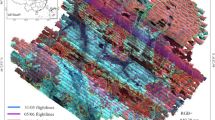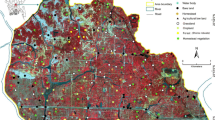Abstract
In this study the high-spatial resolution (0.5 m) hyperspectral imagery with LiDAR data were fused at tree crown object level to classify 8 common tree species in Anyang, Henan, China. First, vertical forest features were extracted from LiDAR point clouds resulting in a canopy height model (CHM), followed by the acquisition of tree crown object (TCO) information from the CHM using a mean shift algorithm. Then, the CHM was combined with a minimum noise fraction transformation (MNF) and enhanced vegetation index (EVI), which were extracted from hyperspectral images. These combined features were used as the input to the SVM to produce a rough classification scheme for different tree species. Finally, a majority voting method was applied to the TCO to produce the final tree species map. The experiment showed that a combination of CHM-spatial-spectral features to classify tree species led to higher accuracy when compared to using only MNF features in the pixel-wise classification. However, the CHM and EVI features had their own limitations, largely depending on different characteristics of the different tree species.







Similar content being viewed by others
References
Alonzo, M., Bookhagen, B., & Roberts, D. A. (2014). Urban tree species mapping using hyperspectral and lidar data fusion. Remote Sensing of Environment, 148, 70–83. doi:10.1016/j.rse.2014.03.018.
Andrew, M. E., & Ustin, S. L. (2009). Habitat suitability modelling of an invasive plant with advanced remote sensing data. Diversity and Distributions, 15(4), 627–640. doi:10.1111/j.1472-4642.2009.00568.x.
Asner, G. P., & Martin, R. E. (2009). Airborne spectranomics: mapping canopy chemical and taxonomic diversity in tropical forests. Frontiers in Ecology and the Environment, 7, 269–276. doi:10.1890/070152.
Asner, G. P., Knapp, D. E., Kennedy-Bowdoin, T., Jones, M. O., Martin, R. E., Boardman, J., & Hughes, R. F. (2008). Invasive species detection in Hawaiian rainforests using airborne imaging spectroscopy and LiDAR. Remote Sensing of Environment, 112, 1942–1955. doi:10.1016/j.rse.2007.11.016.
Bahria, S., Essoussi, N., & Limam, M. (2010). Hyperspectral data classification using geostatistics and support vector machines. Remote Sensing Letters, 2(2), 99–106. doi:10.1080/01431161.2010.497782.
Cao, L., Coops, N. C., Innes, J., Dai, J., & She, G. (2014). Mapping above- and below-ground biomass components in subtropical forests using small-footprint LiDAR. Forests, 5(6), 1356–1373. doi:10.3390/f5061356.
Castro-Esau, K. L., Sanchez-Azofeifa, G. A., Rivard, B., Wright, S. J., & Quesada, M. (2006). Variability in leaf optical properties of Mesoamerican trees and the potential for species classification. American Journal of Botany, 93(4), 517–530. doi:10.3732/ajb.93.4.517.
Chang, C.-C., & Lin, C.-J. (2011). LIBSVM: a library for support vector machines. ACM Transactions on Intelligent Systems and Technology, 2(3), 27:1–27:27.
Comaniciu, D., & Meer, P. (2002). Mean shift: A robust approach toward feature space analysis. IEEE Transactions on Pattern Analysis and Machine Intelligence, 24(5), 603–619.
Coops, N. C., Hilker, T., Wulder, M. A., St-Onge, B., Newnham, G., Siggins, A., & Trofymow, J. A. (2007). Estimating canopy structure of Douglas-fir forest stands from discrete-return LiDAR. Trees, 21(3), 295–310. doi:10.1007/s00468-006-0119-6.
Dalponte, M., Orka, H. O., Gobakken, T., Gianelle, D., & Naesset, E. (2013). Tree species classification in boreal forests with hyperspectral data. IEEE Transactions on Geoscience and Remote Sensing, 51(5), 2632–2645. doi:10.1109/TGRS.2012.2216272.
Dalponte, M., Orka, H. O., Ene, L. T., Gobakken, T., & Nasset, E. (2014). Tree crown delineation and tree species classification in boreal forests using hyperspectral and ALS data. Remote Sensing of Environment, 140, 306–317. doi:10.1016/j.rse.2013.09.006.
Dian, Y., Fang, S., Le, Y., Xu, Y., & Yao, C. (2014a). Comparison of the different classifiers in vegetation species discrimination using hyperspectral reflectance data. Journal of the Indian Society of Remote Sensing, 42(1), 61–72. doi:10.1007/s12524-013-0309-9.
Dian, Y., Li, Z., & Pang, Y. (2014) Spectral and texture features combined for forest tree species classification with airborne hyperspectral imagery. Journal of the Indian Society of Remote Sensing, 1–7. doi:10.1007/s12524-014-0392-6.
Ghosh, A., Fassnacht, F. E., Joshi, P. K., & Koch, B. (2014). A framework for mapping tree species combining hyperspectral and LiDAR data: role of selected classifiers and sensor across three spatial scales. International Journal of Applied Earth Observation and Geoinformation, 26, 49–63. doi:10.1016/j.jag.2013.05.017.
Jones, T. G., Coops, N. C., & Sharma, T. (2010). Assessing the utility of airborne hyperspectral and LiDAR data for species distribution mapping in the coastal Pacific Northwest, Canada. Remote Sensing of Environment, 114, 2841–2852. doi:10.1016/j.rse.2010.07.002.
Jones, T. G., Coops, N. C., Gergel, S. E., & Sharma, T. (2014). Employing measures of heterogeneity and an object-based approach to extrapolate tree species distribution data. Diversity, 6(3), 396–414. doi:10.3390/d6030396.
Liu, L., Pang, Y., Fan, W., & Li, Z. (2013). Fused airborne LiDAR and hyperspectral data for tree species identification in a natural temperate forest. Journal of Remote Sensing, 17(3), 679–695.
Ming, D., Ci, T., Cai, H., Li, L., Qiao, C., & Du, J. (2012). Semivariogram-based spatial bandwidth selection for remote sensing image segmentation with mean-shift algorithm. IEEE Geoscience and Remote Sensing Letters, 9(5), 813–817. doi:10.1109/LGRS.2011.2182604.
Moustakidis, S., Mallinis, G., Koutsias, N., Theocharis, J. B., & Petridis, V. (2012). SVM-based fuzzy decision trees for classification of high spatial resolution remote sensing images. IEEE Transactions on Geoscience and Remote Sensing, 50(1), 149–169. doi:10.1109/TGRS.2011.2159726.
Nowak, D. J., Hirabayashi, S., Bodine, A., & Greenfield, E. (2014). Tree and forest effects on air quality and human health in the United States. Environmental Pollution, 193, 119–129. doi:10.1016/j.envpol.2014.05.028.
Onojeghuo, A. O., & Blackburn, G. A. (2011). Optimising the use of hyperspectral and LiDAR data for mapping reedbed habitats. Remote Sensing of Environment, 115, 2025–2034. doi:10.1016/j.rse.2011.04.004.
Pang, Y. (2013). LiCHY: CAF’s LiDAR, CCD and hyperspectral airborne imager. Beijing, China: Proceedings: 13th International Conference on LiDAR Applications for Assessing Forest Ecosystems.
Shang, X., & Chazette, P. (2014). Interest of a full-waveform flown UV lidar to derive forest vertical structures and aboveground carbon. Forests, 5(6), 1454–1480. doi:10.3390/f5061454.
Tarabalka, Y., Chanussot, J., & Benediktsson, J. A. (2010). Segmentation and classification of hyperspectral images using watershed transformation. Pattern Recognition, 43(7), 2367–2379. doi:10.1016/j.patcog.2010.01.016.
Vapnik, V. N. (1998). Statistical learning theory. New York: Wiley.
Vauhkonen, J., Hakala, T., Suomalainen, J., Kaasalainen, S., Nevalainen, O., Vastaranta, M., Holopainen, M., & Hyyppa, J. (2013). Classification of spruce and pine trees using active hyperspectral LiDAR. IEEE Geoscience and Remote Sensing Letters, 10(5), 1138–1141. doi:10.1109/LGRS.2012.2232278.
White, J. C., Gómez, C., Wulder, M. A., & Coops, N. C. (2010). Characterizing temperate forest structural and spectral diversity with Hyperion EO-1 data. Remote Sensing of Environment, 114(7), 1576–1589. doi:10.1016/j.rse.2010.02.012.
Zhang, K., & Hu, B. (2012). Individual urban tree species classification using very high spatial resolution airborne multi-spectral imagery using longitudinal profiles. Remote Sensing, 4(6), 1741–1757. doi:10.3390/rs4061741.
Zhou, J., Proisy, C., Descombes, X., le Maire, G., Nouvellon, Y., Stape, J.-L., Viennoish, G., Zerubiab, J., & Couteronc, P. (2013). Mapping local density of young Eucalyptus plantations by individual tree detection in high spatial resolution satellite images. Forest Ecology and Management, 301, 129–141. doi:10.1016/j.foreco.2012.10.007.
Acknowledgments
The authors would like to thank Luxia Liu for providing detailed information about the tree species in the research area. This research was supported by National Natural Science Foundation of China (grant No. 41501365).; the Fundamental Research Funds for the Central Universities under grant number 2014QC018; and Key Laboratory for National Geographic Census and Monitoring, National Administration of Surveying, Mapping and Geoinformation under grant number 2013NGCM05.
Author information
Authors and Affiliations
Corresponding author
About this article
Cite this article
Dian, Y., Pang, Y., Dong, Y. et al. Urban Tree Species Mapping Using Airborne LiDAR and Hyperspectral Data. J Indian Soc Remote Sens 44, 595–603 (2016). https://doi.org/10.1007/s12524-015-0543-4
Received:
Accepted:
Published:
Issue Date:
DOI: https://doi.org/10.1007/s12524-015-0543-4




